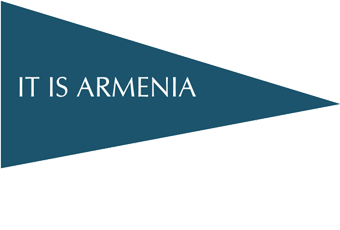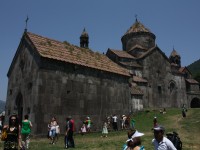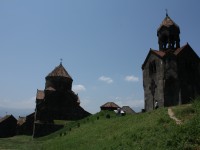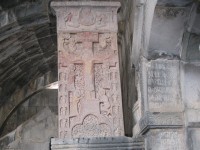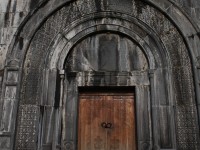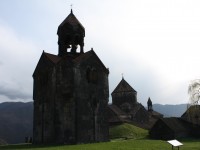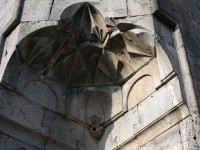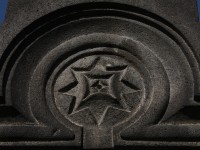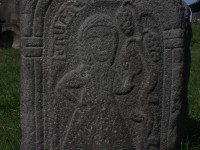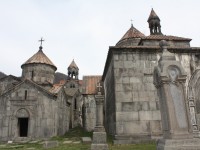Haghpatavank (Haghpat Monastery)
Haghpat monastery is located in the Marz (region) of Lori, 200 km to the north of the city of Yerevan and 20 km far from the city of Alaverdi. It is one of the largest spiritual and cultural centers of medieval Armenia. Haghpat monastery is included in the list of UNESCO World Heritage sites. There are several versions of the etymology of the name of the monastery: Triumphal wall (in Armenian. Haghtakan pat) or Genuine wall (in Armenian. hagh pat) ... In fact, the name comes from the word "dissolute" (in Armenian. Shvayt) and "hate" (in Armenian. Atel) -to hate dissolute way of living... In the current place of Haghpat monastry there used to be the temple of the God of Tir in the pre-Christian Armenia. There is evidence that there was also a monastic complex of the early Christian era. The monastery was founded in its present form in 976 by the Armenian King Ashot III and his wife - the queen Khosrovanuysh. A High School (Vardapetaran) functioned here, where philosophy, rhetoric, theology, music, grammar were taught... Copying and illustrating manuscripts ... In particular, the famous "Haghpat Gospel" was created here. There was the biggest library of medieval Armenia in Haghpat. About 10 thousands of books were stored not only in the monastery, but also in libraries, bookstores, located in the caves around the monastery. The famous thinkers of the time Hovhannes Imastaser, Vardan Areveltsi, Grigor Magistros Pahlavuni, Hovhannes Erznkatsi Pluz later, at the end of the 18th century, the king of the Armenian ashough art Sayat Nova worked there. The church of St. Nshan is the main building of the monastery and was built in 976. It is considered the first masterpiece of the architect Tiridates. It is a cross-shaped domed building with two-story vestries. The rare and valuable frescoes of the 12th century have preserved in St. Nshan. Among them have preserved both the spiritual and secular images. There are the high reliefs of the Armenian king Smbat II and Lori King Kyurike I together holding the maquette of the church on the east facade of St. Nshan. The two narthexes (gavit), three small size churches, two passes-cemeteries, dining room, library, bell tower, several chapels-mausoleums and khachkars (cross-stones) are also included in the monastic complex, besides the Church of St. Nshan. The complex is surrounded by a fence with towers. There are also several small churches outside its territory. A large narthex (gavit), which was built in the early 13th century in the place of the cemetery, founded by the Kyurikyan Princess Mariam in 1185, is adjacent the western side of St. Nshan. The abbot Hamazasp built spacious narthex (gavit) to the north of the main temple in 1257. "The narthex (gavit) of Hamazasp" is adjacent to a small vaulted church from the eastern side. The library is adjacent to the southern part of the eastern wall of the narthex (gavit) of Hamazasp. There was an old building of the library in the 11th century, which was radically rebuilt in the 13th century. The area located between the temple, the narthex (gavit) of Hamazasp and the library was covered with vault and converted into a cemetery in the 13th century. The vaulted corridor-shaped second cemetery is stretched along the length of the eastern side of the temple on the continuation of the first cemetery. These two buildings safely protects the complex of flow of rainwaters. The bell tower, which was built by the abbot Hamazasp in 1245, is located in the eastern part of the complex. It is a three-story building. Seven sanctuaries are located on the first two floors, and the third floor is a rotunda, decorated with columns. The building stands out for its harmonious proportionality and is one of the inimitable monuments of the Armenian architecture. There are also other monuments in the territory of the monastery worthstanding special attention. Among them there are three mausoleums (13th century) of the genus Ukanants, located in the north-west side, near the fence, the corridor shaped cemetery, the khachkar (cross-stone) "Amenaprkich" (Saviour) (1273), which was erected in honor of atabek (governor of the country) and amirspasalar (military commander) Sadun Artsruni and is located near the northern entrance of St. Nshan. The Armenian Catholicos (Supreme Patriarch of the Armenian Gregorian Church) Yeprem Dzoragetsi lived there in 1806-1813 and in fact, the monastery of Haghpat was the residence of the Catholicos during these years. World famous film-producers Sergey Parajanov and Yuri Erzinkyan shooted many of their famous movies in Haghpat.






